Coffee, constancy and fidelity
Synopsis : Why do bees collect pollen of only one type when foraging? Why do they forage repeatedly in the same area? What has coffee got to do with this?
Introduction
Foraging is what my bees should be doing now. The summer nectar flow should be strong – lime, blackberry, rosebay willow herb (RBWH, fireweed) then heather – it’s bonanza time.
But note the qualifier ’should’.
So far, it’s not looking promising.
The lime was hopeless, the blackberry flowered well but doesn’t appear to have yielded much, the fireweed is nearly over (early) and the heather … well, let’s not prejudge anything, but I’m not hopeful.
Not only do those four plants/trees yield nectar, but they also produce pollen and you can often tell what the bees are foraging on by the colour of the packed corbiculae on the hind legs of returning workers.
Despite their overlapping flowering periods the pollen baskets are almost always a single colour. For example, you don’t get deep purple pollen baskets from RBWH speckled with much paler borage pollen, despite the fact you can find both flowering – in a field and its margins – simultaneously.
This is because honey bees tend to forage on one plant species {{1}} on any foraging trip. This feature of the foraging habit of honey bees is termed constancy.
If you marked a foraging worker on a patch of RBWH, watched it fly off to the hive and waited a bit you might well see the marked bee return to the same patch of RBWH and start collecting pollen or nectar again.
This is not constancy but is instead termed fidelity.
Both fidelity and constancy have consequences for plant pollination. It’s therefore unsurprising to discover that some plants have evolved to influence these foraging habits of bees … which is where the coffee comes in.
But I’ll get to that in due course.
Constancy
We’ve known about constancy for thousands of years. Aristotle (Who else?) explained it something like this:
“On each expedition the bee does not fly from a flower of one kind to a flower of another, but flies from one violet, say, to another violet, and never meddles with another flower until it has got back to the hive.”
Who else?
Well … Charles Darwin, Hermann Müller, Gaston Bonnier and Karl von Frisch amongst others.
A little bit of the history is reviewed by Verne Grant (1950) who also discusses some of the studies of constancy from the early/mid 20th Century. Some of these observations – largely relating to generating uncontaminated vegetable seed pedigrees during the Second World War – are confusingly overlapping with fidelity, so bear that in mind if you go rummaging through the archives.
You can quantify constancy in two basic ways:
- analyse the pollen loads of returning foragers
- mark workers and observe them returning to the same flower type over multiple foraging trips
When the first studies were done with marked workers it soon became clear that constancy is maintained both within a foraging flight and between successive flights.
Furthermore, those flights can be spread over several days. In 1850 Hermann Müller demonstrated a single marked forager returning to flowering Salvia every day for 11 days.
The pollen analysis really needs to involve microscopic observation. After all, a 50/50 mix of pollens might be visible to the naked eye, but 95% of one type mixed with traces of others would not.
Bee species and constancy
When pollen is analysed microscopically it becomes possible to quantify constancy and then make comparisons between different bee species.
Grant (1950) tabulated data from a number of studies which I’ve summarised, simplified, averaged and graphed:
Bees are grouped into genera – with honey bees listed under Apis (for Apis mellifera) – and aren’t necessarily comparable as the samples were analysed from Quebec, Colorado and the UK. Furthermore, sample sizes were not equivalent; over 3,000 honey bee pollen loads were analysed, but only 26 from Megachile (leaf cutter bees) and 5 from Anthophora (the largest family of solitary bees).
However, it’s clear from the graph that honey bees show one of the highest levels of constancy, and we can be reasonably confident of this constancy because of the sample size.
The graph is a little misleading; don’t assume that a ‘mixed’ pollen load is a hotchpotch of different pollen types. In the vast majority of cases the bulk of the mixed pollen is actually of a single type. Every one of the ~20% of ‘mixed’ pollen loads from Apis mellifera were actually 95-99% pure. Similarly, at least half of the ‘mixed’ pollen loads carried by Bombus sp. were over 95% pure.
Determinants of constancy
Constancy is clearly widespread in bees, even those that collect a proportion of mixed pollen loads.

Constancy guaranteed
In a dazzling yellow 100 acre field of oil seed rape, where there’s little or no other choice, constancy is perhaps unsurprising. However, constancy also occurs in more natural environments such as a mixed wildflower meadow, or by bees foraging in field margins.
Whilst it might seem like common sense for a bee to stick to one flower type – perhaps for foraging efficiency – that’s a rather difficult concept to study from an evolutionary perspective. And, before you ask, just about any biological phenomena can be explained in evolutionary terms.
It’s worth remembering why the bees are visiting Salvia, or oil seed rape or lime or whatever. They are there to collect pollen and nectar, and the nectar is being produced by the plant to encourage the visits by the pollinator.
And constancy might well be more important to the plant than it is for the bees.
Constancy reduces the losses of pollen to plants of different species.
If the bee flitted from fireweed to borage to bramble and then zoomed off to a lime tree then the amount of pollination that occurred would be reduced.
Thanks to constancy a plant is more likely to become pollinated as the bee probably visited a similar plant earlier on the same or recent foraging trip.
Colour, shape and odour …
Studies dating back over 100 years have demonstrated that the colour, shape and odour of flowers help determine constancy. Plants have evolved distinctive flower shapes and colours to facilitate their recognition by pollinators.
I don’t have time – or know the literature sufficiently well – to review the seminal studies by von Frisch and others on the related areas of colour vision, shape and odour recognition by honey bees.
The predominant colours of insect pollinated flowers – yellow and blue (or combinations of these and/or white) – have evolved because these are the colours readily detected by bees {{2}}, and that probably can be best discriminated against the green of foliage.
… and reward
But there’s more to a flower than shape, colour and odour that can be detected and compared by a visiting bee. The sugar content and volume of nectar can also be measured by bees and more recent studies have shown that these also influence constancy.
The sugar content and volume of nectar varies between plant species and can vary rapidly over time.
Ratnieks and colleagues (Grüter et al., 2011) created an array of artificial blue and yellow flowers and then ‘rewarded’ bees visiting the blue or yellow flowers with ‘nectar’ containing field-realistic levels of sucrose solution. They did this manually and so were also able to vary the number of rewards and the volume of nectar provided by the ‘plant’. Again, volumes were field-realistic, similar to those returned by an individual flower.
Having trained the bees (24 training combination, with 9 bees on each), they then recorded subsequent visits to the coloured flowers.
These studies showed that increasing rewards, volume or the sucrose concentration all increased constancy, with the least rewarding combination leading to 75% constancy, and the most rewarding situation resulting in over 98% constancy.
In conclusion, constancy – the repeated visits to a single flower type by a forager – is widespread in bees and determined by the recognition of the flower by the visiting pollinator. This recognition includes, but probably isn’t limited to, the colour, shape, odour of the flower and the reward offered.
Most of these studies have been conducted on honey bees, but I’d bet the conclusions also broadly apply to other pollinators. Bats are important pollinators for some tropical plants. I’d not expect colour to be relevant (visits are likely to be at night) but odour and nectar strength probably are, and shape might be distinctive.
Fidelity
How far away can you see a bee from? A few metres perhaps (to distinguish a worker from a drone, or a bee from a syrphid)?
Over what distance could you discriminate a bee marked with a spot on her thorax from an unmarked one? {{3}}
Hermann Müller’s demonstration of constancy with marked foragers in 1850 was possible because the bees returned, not to any flowering Salvia, but to the precise patch of Salvia in which the bees had been marked and Müller had chosen to watch.
So, the fact that the worker returned to Salvia showed constancy, but the worker returning to the same patch of flowering plants demonstrated fidelity.
Fidelity has not been studied in anything like the same amount of detail as constancy. We know it occurs and we now know that honey bees differ in their fidelity from some of the other bee species investigated. However, we don’t properly understand what determines fidelity.
Understanding fidelity is probably important where attempts are made to improve habitat for pollinators; how large do patches of flowers need to be to attract and then retain bees so that they spend more time collecting nectar and less time searching for nectar?
Since one of the end products of a pollinator visit is pollination the fidelity of bees will influence both seed set (how well plants are pollinated) and the gene flow of plants in an environment.
If fidelity is low then pollination is likely to also be low, but genes from one plant will probably be widely spread in the environment. Conversely, if fidelity is high, pollination rates and consequently seed set should be good, but genes from any individual plants will be more localised, rather than being widely dispersed.
Enough theory … are honey bees high fidelity?
Fragoso and Burnet (2023) compared the fidelity of honey and bumble bees using a mark-reobservation study on patches of alfalfa (Medicago sativa). They planted a series of large and small patches of alfalfa in an otherwise grass-filled and invariant environment. The density of alfalfa plants in large (225 plants) and small (100 plants) patches was identical.
Honey bees or wild Bombus impatiens (common eastern bumble bee) visiting the patches during peak bloom in two successive years were captured, uniquely marked and released.
Revisits of marked bees to the original patch, or others in the study area, were recorded by manual observation every hour over 6 hours a day for ~1 month {{4}}.
Results are expressed in terms of patch-faithful (pale colour) and non-faithful (dark colour) for each of the five study patches.
Three things are immediately obvious from the results;
- honey bees show a markedly higher level of patch fidelity than bumble bees (for any patch, the proportion of the bar that is in the pale colour is larger for honey bees). Over the two year study, patch-faithful observations were 76% for honey bee and 47% for bumble bees.
- both honey bees and the bumble bee species studied favoured the larger patches of alfalfa (the LF and LN bars are higher).
- patch fidelity varied for bumble bees, who were more likely to return to a larger rather than smaller patches, than for honey bees (the proportion of the bar that was a lighter colour is greater for larger patches)
So, honey bees do exhibit higher fidelity than bumble bees … or at least this species of bumble bee on alfalfa.
Not all pollinators are equal
These types of studies are time consuming to conduct and may be influenced by the environment. Similar studies, of different species of bumble bees foraging on Delphinium or Gentiana have shown fidelity can be higher at 67% or 78% respectively (compared with the 47% recorded on alfalfa), though I’m not aware of a simultaneous comparative study of bumble bees and honey bees.
Inevitably, there will be subtle variations between pollinators of different types. These variations will be influenced by other forage available, the needs of the colony, the particular rewards provided by the plants.
The differences between honey bees and bumble bees highlight the – frankly crass – greenwashing attempted by companies who parachute a few honey bee hives into an environment to “support pollination”.
Not only will the honey bees potentially compete with native bees, but the consequences of the pollination will be different. The greater fidelity of honey bees will reduce gene flow in the plant population, resulting in a patches-within-patches pattern.
The differences in fidelity are likely to be influenced by the foraging strategy of different bee species; honey bees use cooperative foraging and dance communication to ‘advertise’ suitable areas whereas bumble bees practice repeated sequential visits to a series of locations (trapline foraging).
Whatever the strategy, for a bee to successfully return to a location it has to remember where that location is within the landscape.
Which, finally, allows me to discuss coffee.
Caffeine enhances a pollinator’s memory of reward
This site runs on coffee. Generous supporters pay for the server fees and backup space {{5}}, and for the coffee that fuels my late night writing marathons that produce posts like this one.
It is the relatively low doses of caffeine in coffee that enhances cognition, increases alertness and attentional performance and boosts memory retention {{6}}
In high doses it is lethal.
For a human the LD50 is ~175 mg/kg, equivalent to ~80 espressos for a 70 kg adult.
Caffeine is produced by a range of plants native to Africa, East Asia and South America. It has a bitter taste and probably evolved to prevent grazing by herbivores. In addition to being present in the leaves, some plants – including the genera Citrus and Coffea – produce scented flowers, the nectar of which contains low doses of caffeine.
Notably, when pollinated by bees, Coffea and Citrus plants produce more fruits and seeds.
This prompted Jeri Wright and colleagues to investigate whether caffeine affects the learning and memory of pollinators (Wright et al., 2013). The hypothesis was simple; caffeine stimulates memory, bees are rewarded with nectar when they visit a plant, repeated visits (necessitating memory) are needed for pollination … perhaps the low concentrations of caffeine in some nectars improve the ‘memory of reward’ and so would encourage repeat visits (over hours or days)?
Caffeine in nectars
Wright and colleagues quantified the amount of caffeine in a range of Coffea and Citrus species. Levels were low, perhaps from ~80% to as low as 1% of the level of caffeine in instant coffee {{7}}. However, all 7 species tested produced detectable amounts of caffeine in their nectar, and the level of caffeine was unrelated to the sucrose concentration present.
Notably the level of caffeine in nectar was well below the amount determined to repel honey bees, and a tiny fraction of the levels of caffeine in the vegetative and seed tissues of the plant which are present to deter grazers.
This would suggest – if pollinators are able to respond to the caffeine present in nectar – that they have driven the selection of differential concentrations of the drug in different tissues of the plant, such that the caffeine in nectar is not repellent but remains pharmacologically active.
So how do you test if the levels of caffeine present in nectars is pharmacologically active?
How do you test the memory of honey bees?
The proboscis extension reflex
A bee will extend its proboscis in response to a smell they recognise (remember) being associated with a reward.
Bees were trained to respond to a floral scented sucrose solution by exposing the bee at 30 second repeats – the approximate rate of flower visitation by foragers – to the odour and reward.
The sucrose solution was spiked with different concentrations of caffeine, and both the rate of learning and the long-term memory was then tested.
Caffeine in the nectar caused a weak but detectable enhancement in learning but profoundly enhanced long-term memory.
When tested 24 hours after training, three times as many bees remembered the florally scented solution and responded. When tested 72 hours after training about twice as many bees responded to the floral odour.
Caffeine enhances memory of reward in honey bees … but how?
Making memories
The boost caffeine provides to mammalian memory is partly due to its pharmacological activity as an adenosine receptor antagonist. This is way outside of the scope of a general interest beekeeping blog and I don’t want to lose the 0.0034% of readers remaining who at least started this post …
Suffice to say that caffeine induces long-term potentiation of neurones in the hippocampus and this is a critical component of memory formation.
And, experiments suggest that it works in essentially the same way in honey bees.
Bees have Kenyon cells (KC) in the mushroom bodies of the brain which are broadly equivalent to hippocampal neurones. Using sensitive electrophysiological methods, Wright and colleagues directly measured the activity of the KCs and showed that they responded in a similar way to that expected when exposed to caffeine. Known adenosine receptor antagonists (active in mammalian cells) also worked against KCs.
Memory, constancy and fidelity
This suggests that there are broad similarities between the ways memories are formed in the human/mammalian brain and that of the honey bee and – to get us back on track somewhat – that components of nectar could enhance memory and so could potentially increase constancy and fidelity.
Not all plants produce caffeine, but memory formation of plant patches and nectar sources by honey bees does not need caffeine, but is enhanced by the presence of caffeine at low levels.
Formal experiments on a role for caffeine (or potentially other compounds that work in a similar manner) in enhancing memory formation and so increasing constancy and/or fidelity remain to be done. Do bees show increased constancy for plants that express caffeine?
However, the differences observed in constancy or fidelity between honey bees and bumble bees is not because only honey bees respond to caffeine … recent studies have, unsurprisingly, shown that bumble bees also respond to caffeinated nectar in a similar manner (Arnold et al., 2021).
Decaffeinated readers may not remember the suggestion that the carpet of dead bees sometimes found under lime trees may be due to chemical deception i.e. caffeine, or a caffeine-like compound, inducing persistent foraging even after the trees have stopped yielding nectar, leading to eventual starvation.
Tilia tomentosa (the silver lime which is predominantly associated with bee deaths) nectar does contain caffeine, but so do other species of lime trees not associated with bee deaths.
All of which is a bit of a moot point this year as my honey supers echoingly confirm that none of my bees visited the nearby lime trees when they briefly flowered 🙁 .
I fear that the only constancy and fidelity my colonies will show this summer is to fondant …
References
Arnold, S.E.J., Dudenhöffer, J.-H., Fountain, M.T., James, K.L., Hall, D.R., Farman, D.I., et al. (2021) Bumble bees show an induced preference for flowers when primed with caffeinated nectar and a target floral odor. Current Biology 31: 4127-4131.e4 https://www.cell.com/current-biology/abstract/S0960-9822(21)00897-6.
Fragoso, F.P., and Brunet, J. (2023) Honey bees exhibit greater patch fidelity than bumble bees when foraging in a common environment. Ecosphere 14: e4606 https://onlinelibrary.wiley.com/doi/abs/10.1002/ecs2.4606.
Grant, V. (1950) The Flower Constancy of Bees. Botanical Review 16: 379–398 https://www.jstor.org/stable/4353438.
Grüter, C., Moore, H., Firmin, N., Helanterä, H., and Ratnieks, F.L.W. (2011) Flower constancy in honey bee workers (Apis mellifera) depends on ecologically realistic rewards. Journal of Experimental Biology 214: 1397–1402 https://doi.org/10.1242/jeb.050583.
Wright, G.A., Baker, D.D., Palmer, M.J., Stabler, D., Mustard, J.A., Power, E.F., et al. (2013) Caffeine in Floral Nectar Enhances a Pollinator’s Memory of Reward. Science 339: 1202–1204 https://www.science.org/doi/10.1126/science.1228806.
{{1}}: I’ll use the generic word ‘plant’ to include trees as well.
{{2}}: And other pollinating insects.
{{3}}: With queens, less than 50 cm sometimes!
{{4}}: Don’t believe the scientists who tell you about their dynamic and exciting careers!
{{5}}: Thank you!
{{6}}: At least I think that’s what it does … I’ll probably remember after another cappuccino.
{{7}}: Which I can assure you is almost undetectable.
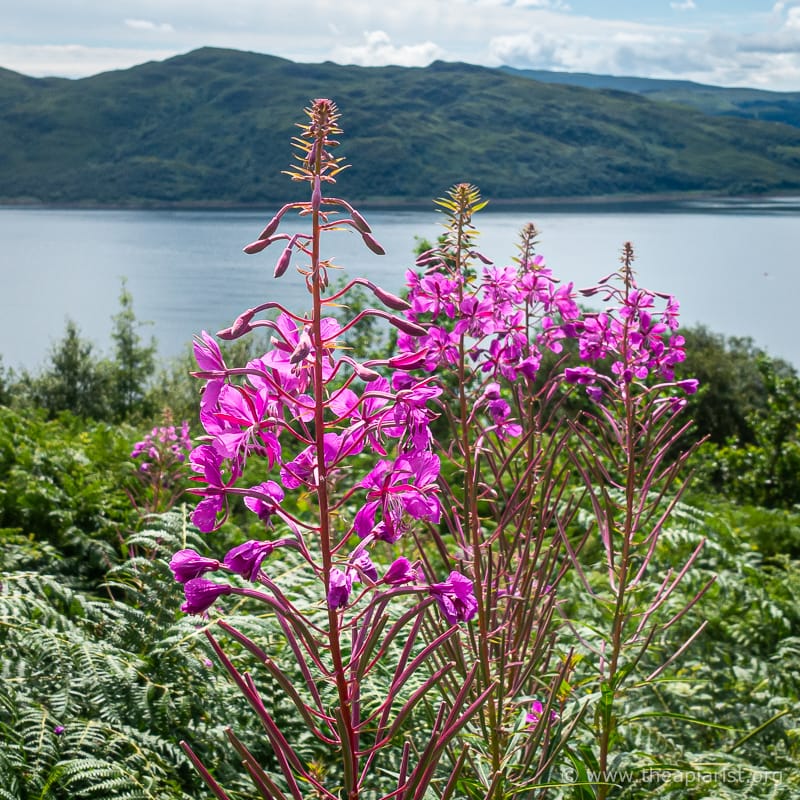
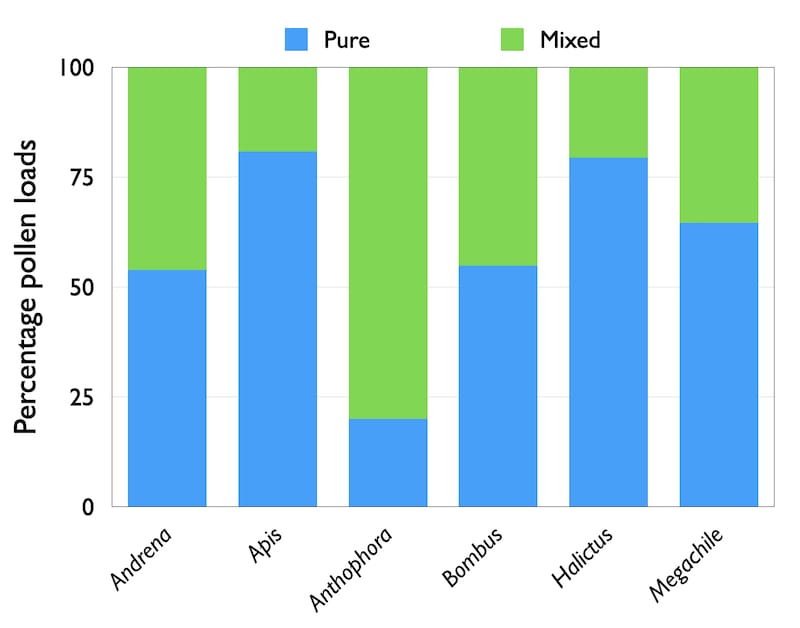
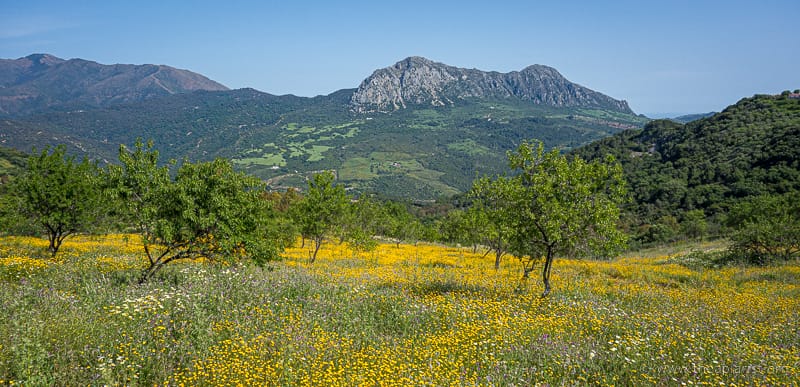
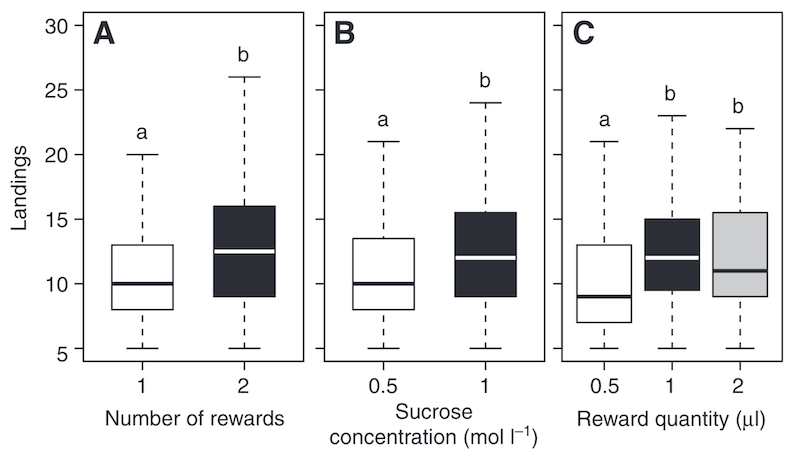

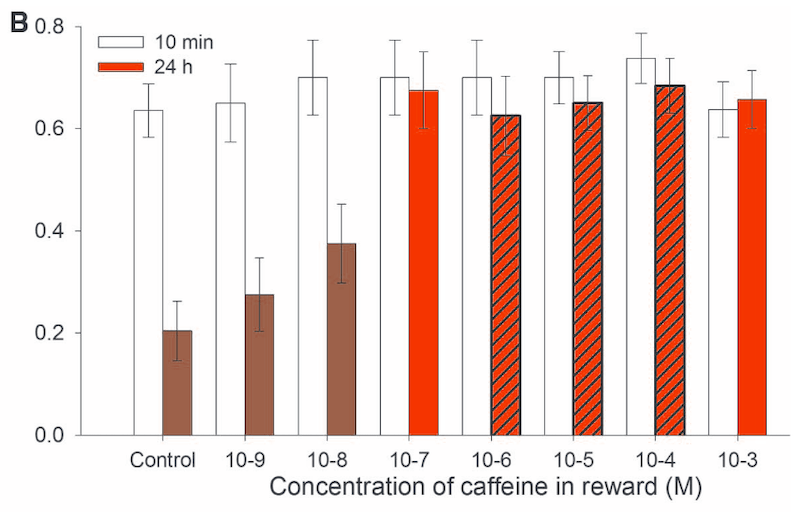
Join the discussion ...